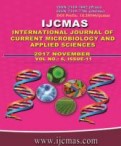


 National Academy of Agricultural Sciences (NAAS)
National Academy of Agricultural Sciences (NAAS)

|
PRINT ISSN : 2319-7692
Online ISSN : 2319-7706 Issues : 12 per year Publisher : Excellent Publishers Email : editorijcmas@gmail.com / submit@ijcmas.com Editor-in-chief: Dr.M.Prakash Index Copernicus ICV 2018: 95.39 NAAS RATING 2020: 5.38 |
An experiment was conducted under laboratory conditions in petri-plates, to study the effect of bioactive molecules extracted from roots and aerial parts of Tagetus plant on Meloidogyne javanica (second stage larvae) which forms root-knot in various crop plants and create severe loss. For its efficacy evaluation, the extracted compounds, initially the extracted fractions were converted into suitable E.C. (emulsified concentration) formulations and prepared formulations were tested against second stage larvae of Meloidogyne javanica under lab conditions. Solvent used for isolation were hexane(A), dichloromethane(B), ethyl acetate(C), acetone(D) and methanol(E), in which the first three solvents were non-polar in nature. The activity of EC formulations developed separately by isolated fractions A, B, C, D and E of Tagetus plant biocidal compounds varied according to compound doses and time of exposure. A great difference, in all respect, in the toxicity of all the developed formulations was observed. Results clearly indicates that the formulations developed from non-polar fractions exhibited severe impact on mortality and paralysis of second stage juveniles of Meloidogyne javanica in comparison to the formulations developed from polar fractions. But results indicate that the maximum mortality rate between the non-polar fractions were present in hexane soluble compounds. So, it is clear that maximum mortality rate was present in highest non-polar compound and followed by less non-polar compounds. The paper deals with the study of the effect of three different, non-polar compounds fractionated at different levels of polarity and their impact on juveniles.
 |
 |
 |
 |
 |